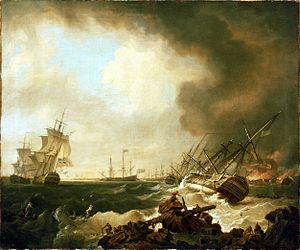Dublin-class ship of the line
This article includes a list of references, related reading, or external links, but its sources remain unclear because it lacks inline citations. (February 2013) |
 HMS Resolution (on her starboard side in the foreground)
| |
| Class overview | |
|---|---|
| Name | Dublin |
| Operators | |
| Preceded by | 1745 Establishment |
| Succeeded by | Template:Sclass- |
| In service | 6 May 1757 – 1802 |
| Completed | 7 |
| Lost | 2 |
| General characteristics | |
| Type | Ship of the line |
| Tons burthen | 1546 87/94 |
| Length |
|
| Beam | 46 ft 6 in (14.17 m) |
| Depth of hold | 19 ft 9 in (6.02 m) |
| Propulsion | Sails |
| Complement | 550 |
| Armament |
|
| Notes | Ships in class include: Dublin, Norfolk, Shrewsbury, Lenox, Warspite, Resolution, Mars |
The Dublin-class ships of the line were a class of seven 74-gun third rates, designed for the Royal Navy by Sir Thomas Slade.
Design
The Dublin-class ships were the first 74-gun ships to be designed for the Royal Navy, and marked the beginning of a more dynamic era of naval design than that in the ultra-conservative Establishment era preceding it.
Slade's draught was approved on 26 August 1755 when the first two orders were transmitted to Deptford Dockyard. The design was some 4½ feet longer than the preceding 70-gun ships of the 1745 Establishment, with the extra length making provision for an additional (14th) pair of 32-pounder guns on the lower deck compared with the 13 pairs of the 70-gun ships. They were nominally ordered as 70-gun ships (although always designed to carry 74), but redesignated as 74-gun during construction.
Ships
- Builder: Deptford Dockyard
- Ordered: 26 August 1755
- Laid down: 18 November 1755
- Launched: 6 May 1757
- Completed: 1 July 1757
- Fate: Broken up, May 1784
- Builder: Deptford Dockyard
- Ordered: 26 August 1755
- Laid down: 18 November 1755
- Launched: 28 December 1757
- Completed: 23 February 1758
- Fate: Broken up, December 1774
- Builder: Wells & Company, Deptford
- Ordered: 28 October 1755
- Laid down: 14 January 1756
- Launched: 23 February 1758
- Completed: 2 May 1758 at Deptford Dockyard
- Fate: Condemned and scuttled at Jamaica 12 June 1783
- Builder: Chatham Dockyard
- Ordered: 28 October 1755
- Laid down: 8 April 1756
- Launched: 25 February 1758
- Completed: 26 May 1758
- Fate: Sunk as breakwater, 1784; later raised and broken up May 1789
- Builder: Woolwich Dockyard
- Ordered: 28 October 1755
- Laid down: 1 May 1756
- Launched: 15 March 1759
- Completed: 12 April 1759
- Fate: Sold to be broken up, August 1784
- Builder: Thomas West, Deptford
- Ordered: 14 November 1755
- Laid down: November 1755
- Launched: 8 April 1758
- Completed: 27 July 1758 at Deptford Dockyard
- Fate: Broken up, November 1801
- Builder: Henry Bird, Northam, Southampton
- Ordered: 24 November 1755
- Laid down: December 1755
- Launched: 14 December 1758
- Completed: 23 March 1759 at Portsmouth Dockyard
- Fate: Wrecked, 20 November 1759 during Battle of Quiberon
References
- Lavery, Brian (2003) The Ship of the Line – Volume 1: The development of the battlefleet 1650–1850. Conway Maritime Press. ISBN 0-85177-252-8.
- Lyon, David (1993) The Sailing Navy List. Conway Maritime Press. ISBN 0-85177-617-5
- Winfield, Rif (2007) British Warships in the Age of Sail: 1714 – 1792. Seaforth Publishing. ISBN 978-1-86176-295-5
